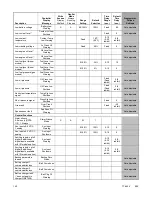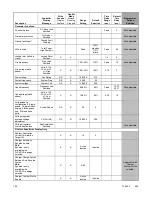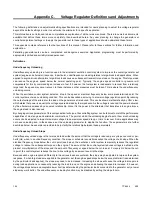
TP-6694
9/20
167
Frequency Setpoint or Cut-In Point
The point at which the underfrequency unloading begins to take effect is adjustable, allowing the system to be tailored for each
application. Because the characteristics of the engine have the largest effect on the system’s performance, the engine’s
response should determine the unloading point. The unloading setpoint is the frequency below which the excitation control will
reduce the voltage so that the engine may begin to recover.
The cut-in point, or frequency setpoint, should be set 0.5- 3.0 Hz lower than the normal steady-state band of operation. If the
engine normally operates within a very narrow range of speeds close to the nominal, a setpoint of 0.5 to 1.0 Hz below nominal
should be suitable. If the engine normally operates over a wide range of speeds, the setpoint may need to be 2.0- 3.0 Hz from
the nominal. The underfrequency unloading function can be eliminated by setting the cut-in point below the minimum expected
operating frequency.
Example
A 90 kW load is applied to a 100 kW, 60 Hz generator set driven by a turbocharged diesel engine with an electronic control
module (ECM). The speed drops 10% and takes 20 seconds to recover to at least 59.5 Hz. The voltage, meanwhile, drops from
480 to 460 and recovers to 480 within 15 seconds. Therefore, some underfrequency unloading should be provided. A good
starting point would be a frequency setpoint or cut-in of 59 Hz. A slope of 15 volts per-cycle-per-second is appropriate as well.
If after these adjustments the speed recovers very quickly, in about 5 seconds, but the voltage drops below 440 volts, the slope
should be reduced to 12 volts per cycle. More adjusting may be required to get the most desirable compromise between speed
and voltage.
Three-Phase Sensing
Three-phase sensing describes how the excitation control or voltage regulator determines the condition of the alternator output
voltage. Early types of regulators sensed the voltage on just one phase of the alternator. Single-phase sensing is not uncommon
today as most alternators are designed to produce balanced, equal voltage on all three phases. If the loads applied to the
generator set including no load are equal and balanced, the output voltage on each phase will be nearly equal.
However, in some applications, individual phases may have unequal or unbalanced loads. In these cases, the output voltages
will not be equal on each phase. In general, the phase with the greatest load will have the lowest voltage while the phase with
the least load will have the highest voltage. This is true regardless of the type of sensing used in the regulator system. A single-
phase sensing excitation controller will keep the voltage of the sensed phase at the voltage adjustment value. A three-phase
sensing system will average the three phases and hold the average to the adjustment setting. The average is the sum of the
voltages of three phases divided by 3.
As stated above, three-phase sensing does not eliminate the unequal voltage phenomenon. Three-phase sensing balances the
inequality of voltage between the phases to the desired value. In other words, if a system with unbalanced loads uses a single-
phase control feedback, the voltage on the sensed phase would be at the setpoint while the other two phases would vary by
their proportional loads. For example, if the sensed phase had rated load while the two other phases were only loaded at half
the rated value, those two phases would have higher-than-rated voltage which may be undesirable. If a three-phase sensing
feedback were utilized, the phase with rated load would be regulated to a voltage slightly below the rated voltage while the other
two phases would be slightly above the rated voltage (but lower than in the previous case). The sum of the three, divided by 3,
would be equal to the regulation setpoint.
In a single-phase system, line-to-line voltage is held equal to the line-to-line voltage adjust setting. In a three-phase system, the
average of the three line-to-line voltage is regulated to the voltage adjust setting. In some cases, it may be desirable to keep
one phase at a particular value. Modify the voltage adjust setting higher or lower accordingly for any unique requirements for
the particular application.
Summary of Contents for APM402
Page 6: ...6 TP 6694 9 20 ...
Page 16: ...16 TP 6694 9 20 ...
Page 42: ...42 TP 6694 9 20 ...
Page 78: ...78 TP 6694 9 20 ...
Page 112: ...112 TP 6694 9 20 ...
Page 120: ...120 TP 6694 9 20 ...
Page 124: ...124 TP 6694 9 20 Figure 54 20 150 kW Permanent Magnet Single Phase Alternators ADV 5875AB 1 ...
Page 125: ...TP 6694 9 20 125 Figure 55 20 300 kW Permanent Magnet Alternators ADV 5875AB 2 ...
Page 128: ...128 TP 6694 9 20 ...
Page 131: ...TP 6694 9 20 131 Figure 61 Battery Charger to Controller Connections DEC 3000 Controller ...
Page 153: ...TP 6694 9 20 153 Figure 90 Controller Wiring Connections GM78246G 1 ...
Page 154: ...154 TP 6694 9 20 Figure 91 Controller Wiring Connections GM78246G 2 ...
Page 171: ......






































